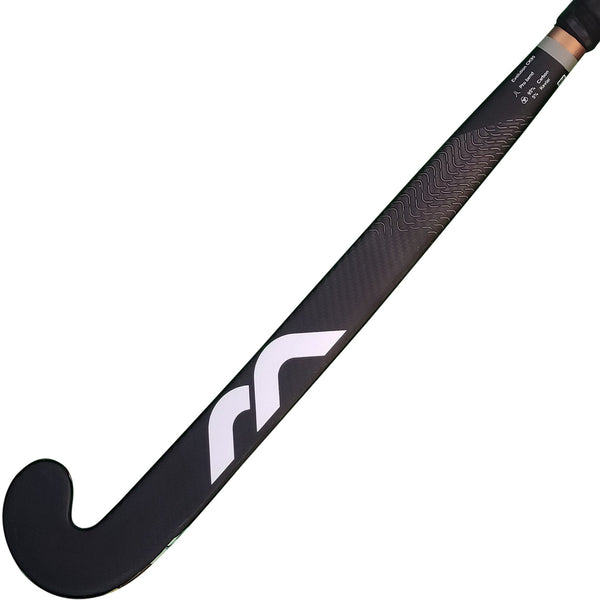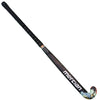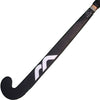Elite CF95 Pro (2023)
- Description
- Technical Details
- Player Profile
The second model in the Elite range, the 95% carbon lay-up is placed across a fibreglass micro-skeleton giving more touch and feel than the CK95. The Pro Bend is suited for a wide variety of playing styles, without the aggression of the Ultimate bend.
- 95% Carbon
- Pro Low Bend (24mm @ 230mm)
- Dual process vibration control (Piezo-Electric fibres, M-Gel)
- Nano-Polymer Resin
- X-fibre backhand edge
PRO BEND
The Mercian Pro Bend incorporates a near maximum 23.5mm bow positioned just below the mid-point of the shaft, approximately 250mm from the bottom of the stick. The shaft has then been shaped to give a thinner profile under the right hand and a balance point that favours the head end of the stick. This gives a combination of great stick turn-over due to the shape but enhanced hitting power because of the balance point and sweet spot, the hitting power is also enhanced because the head is 1.5mm thicker than the ultimate bend.
CARBON FIBRE: CF95 – 95% CARBON
One of the most common questions asked by the consumer is ‘how much carbon?’ with the perception that more is better. That is far from the truth, so to shed a little light. Firstly the quality of carbon (manufacturing point) is important. Toray (Japanese) Carbon is often considered the best, but Carbon from Germany, Scotland and South Africa (to name a few) are all high-quality. Sticks are usually made in Pakistan and most major brands will import Carbon into Pakistan to make sticks. Local made carbon is not usually as good. But it is difficult to know if a brand uses imported carbon. The number of filaments in the carbon fibre is relevant, 1K, 3K etc relate to the number of filaments of pure carbon within a fibre or ‘tow’. 1K is used in aeronautical industry and electronics. 3K and 6K are commonly used in sport as they have the right combination of weight and strength. Anything over 6K is very dense and too heavy for sports equipment. Again this isn’t a common line of questioning from the consumer but may come up. Carbon fibres are a straight line material and so provide stiffness in a single direction. To provide stiffness in multiple directions the fibre can be woven into a multi-directional sheet (seen as an obvious weave in the sticks surface) or single direction sheets can be layered over each other to create the multi-directional stiffness. 40% of the weight of a composite stick comes from the resin within it. So, a stick can’t be 100% carbon. However, it can be claimed that 100% of the composite materials in a stick are carbon. Mercian do not believe this gives optimal strength and so always combine the carbon overlay with a composite micro-skeleton made from fibreglass, Kevlar (aramid) and basalt. Carbon is stiff but brittle. The stiffness means that the energy created by the player when striking the ball – hit / slap – transfers to the ball and is not absorbed by the stick. Maximum energy transfer allowed by the FIH is 98%. But this stiffness means that the stick will not absorb energy on trapping / receiving so needs soft hands! The brittleness of carbon means that if the fibres are broken (stick tackle / post impact) they will crack, and the stick can or will fail. This is not a manufacturing fault. Other materials can be used in conjunction with carbon to get a positive performance outcome. Special chemicals are used with paints and lacquers to get them to bend to the top layer of carbon and create high-quality graphics.
QUAD CARBON SLEEVE – Q.C.S
Mercian’s QCS technology is based around enhancing the already common braided technology. Braiding as a dictionary definition means: ‘to interweave several strands of (hair, thread,etc); to plait’ By weaving carbon strands together you create a carbon sleeve, this provides 360 degree, seamless strength within a stick. Using such a full-length sleeve creates a softer feel, a lighter weight, but creates exceptional energy transfer and therefore power. Mercian then overlay the full-length sleeve with 3 more smaller sleeves to offer enhanced protection at the three identified stress points – base of handle, backhand hitting zone and stick ‘heel’. By utilising these four sleeves we create a unique structure for delivery of maximum power and durability.
TCDK (tungsten carbide diffused Kevlar)
Kevlar is the registered trademark for a para-aramid synthetic fibre, also known simply as ARAMID in other sticks. This high-strength material was first commercially used in the early 1970s as a replacement for steel in racing tires. Typically it is spun into ropes or fabric sheets that can be used as such or as an ingredient in composite material components.Currently, Kevlar has many applications, including bulletproof vests, because of its high tensile strength-to-weight ratio; by this measure it is 5 times stronger than steel. Tungsten carbide (chemical formula WC) is a chemical compound (specifically, a carbide) containing equal parts of tungsten and carbon atoms. In its most basic form, tungsten carbide is a fine grey powder, Tungsten carbide is approximately twice as strong as steel, For TCDK the fine powder version of WC is diffused through a sheet of Kevlar in the manufacturing process further enhancing the natural characteristics of the material and increasing both its strength and more specifically its durability.
PEIZO-ELECTRIC FIBRES
Piezo-electric fibres are included in all the Evolution sticks they are used to ‘harvest’ the vibrations created in these super-stiff sticks and turn them into heat. The result of this is efficient vibration dampening. Its achieved because the molecules within the material are active, the force applied to them (vibrations) causes the fibres to bend and emit a small electric charge that is dispelled as heat. The technology originally used by Head in tennis, applied those forces through an electrode to counter-act the vibrations (this isn’t present in hockey sticks!)
NANO-POLYMER RESIN
The particles within our resins have been altered at a nano-size level (10 x below microscopic) Instead of using nano-carbon particles, the use of rubberized polymers creates a more flexible but stronger bond between the composite layers. This increases the stiffness of the sticks and reduces de-lamination.
FIBREGLASS – CF95 – 5% FIBREGLASS
The basic synthetic material that makes the initial micro-skeleton in all Mercian composite sticks. Simple fibreglass stands, dipped in custom resins and then woven into sheets to be combined with other materials to create the combinations relative to the specific stick’s performance.
- The Elite CF95 is a PRO BEND (24MM @ 230MM), high carbon stick. It suits aspirational intermediate players or elite athletes*.
- The Pro Bend is a standard low bow which eases the execution of drag flicks, 3D skills and overhead passes, but is also suitable for standard slaps, hits and great close control.
- It is suitable for a (advanced*) defensive player who enjoys push passing, hitting and slapping as primary skills. (Jab and block tackling are skill, not stick, dependant). The lower balance point gives some head weight to aid ball control.
- It is suitable for a (advanced*) midfield player who enjoys running with the ball but is not focused on lifting the ball off the ground. The head weighting aids hitting for shooting and passing as well as tight control.
- It is suitable for a (advanced*) forward who likes to focus on accurate control, powerful hit and slap shots and running with the ball with controlled movement.














